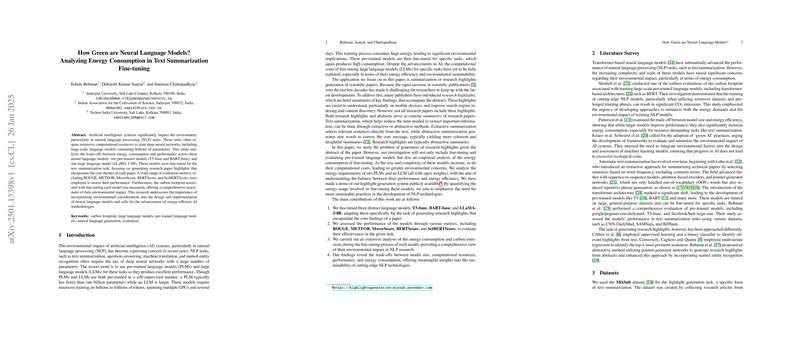The paper "How Green are Neural LLMs? Analyzing Energy Consumption in Text Summarization Fine-tuning" focuses on the environmental impact of fine-tuning neural LLMs for text summarization tasks. This research addresses the growing concern about the substantial energy consumption and subsequent carbon footprint associated with deep neural networks, particularly in the field of NLP. The authors investigate three models: T5-base, BART-base, and LLaMA 3-8B, with the objective of assessing their energy efficiency and performance in generating research highlights from scientific papers.
Key Findings and Contributions
- Model Fine-tuning: The paper fine-tunes three distinct models, each with different architectures and parameter counts. T5-base and BART-base, both pre-trained models, share a similar scale, while LLaMA 3-8B stands as a significantly larger LLM with billions of parameters. This contrast allows the authors to explore the relationship between model size and environmental impact.
- Performance Metrics: The models were evaluated using a comprehensive set of metrics: ROUGE, METEOR, MoverScore, BERTScore, and SciBERTScore. T5-base and BART-base exhibited competitive performance, particularly in lexical overlap metrics like ROUGE and METEOR. However, LLaMA 3-8B showed improved semantic alignment in MoverScore and both variants of BERTScore, possibly indicating a preference for different phrasings rather than direct overlaps.
- Energy and Environmental Impact Analysis: A pivotal aspect of this paper is the quantification of energy consumption and carbon emissions during model fine-tuning. The methodology leverages established frameworks for estimating carbon footprints, considering multiple factors such as power consumption, hardware specifications, and geographic energy carbon intensity (CI). LLaMA 3-8B, while delivering strong performance, demonstrated a markedly higher carbon footprint due to its scale and complexity. The analysis also highlights that different data centers (based on CI) can further impact these results.
- Implications for Sustainable AI: The paper underscores the need for balancing performance with environmental sustainability. It suggests incorporating energy efficiency as a core consideration in model selection, especially in resource-constrained or environmentally conscious settings. The paper advocates for advancements in AI methodologies that prioritize greener practices without compromising performance.
Conclusion
The paper presents a thorough comparative analysis of the energy efficiency and performance capabilities of contemporary neural LLMs in NLP tasks, specifically focusing on text summarization. The results indicate intricate trade-offs between model size, effectiveness, and environmental impact. By spotlighting energy consumption as a critical factor, this research calls for concerted efforts to mitigate the ecological footprint of AI advancements, proposing that future work in this domain should integrate sustainability as a primary design and operational criterion. This paper contributes to the ongoing discourse on "green AI" by providing empirical evidence and promoting methodological innovations that respect environmental limitations.
